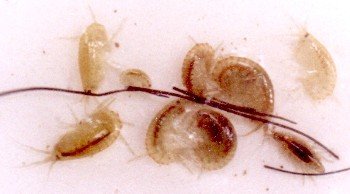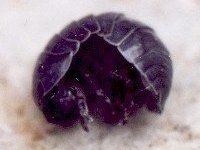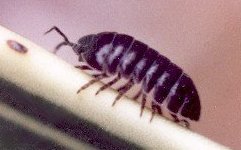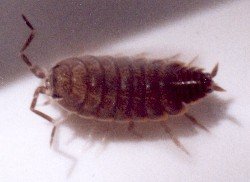Crustaceans
by Valerie (October 6, 2002)
|
While we don't have anything as spectacular as lobsters, crabs or shrimp living in our yard, there really are some crustaceans. The smallest are almost microscopic, while the largest are less than ½ inch long.
While the extremely small crustaceans dominate a small pool, our biggest pond is host to myriad scud, a freshwater amphipod also called sideswimmer. When I was a child in Illinois, these creatures could be found in clear, spring-fed streams. They grew up to about ½ inch long, but the ones that are in our pond now are never over ¼ inch. The scud are closely related to beach fleas or beach hoppers, which live on just about all sandy ocean shores. They are laterally flattened and usually assume a humped over posture. Fast swimmers, the scud manage to evade the mosquito fish in the pond by hiding in the roots of the water hyacinths. They are prolific and can often be found in mating pairs. While the majority of crustaceans are aquatic, there are also very successful populations of terrestrial isopods. Deep sea isopods can reach a length of several inches, but the common isopods found on dry land are much smaller. There are two species in our yard: pillbugs and sowbugs.
Pillbugs are also called rolypolies and doodlebugs. They are smooth, rounded little creatures that can roll up into a tight ball. Both they and the sowbugs are scavengers and do a wonderful job of cleaning up dead vegetation and dog poop in the yard. The pillbugs are rather resistant to drought and can survive well through the hottest part of the summer. However, they do best during wet weather and can be found in the hundreds after rains. While some people consider them to be pests, we've never been bothered by them as they don't bite, don't get into the house very often, and don't seem to be as destructive to plants as many other invertebrates. However, I once did have the misfortune of allowing them to completely eat the top layer off some leather shoes that were outside on a damp night while camping, so they can be destructive if one is careless.
Pillbugs and sowbugs, being crustaceans, breathe by means of gills. This is why they need moisture, but they will drown if submerged. The eggs of both creatures are kept in a pouch on the underside of the female, and can be seen as a white blotch on the underside near the tail. The young of both crustaceans look a lot like the adults, and molt several times before reaching their full size. I've sometimes found pillbugs that look like they are half light-colored and half dark. This is because they shed their exoskeleton one half (front vs. back) at a time, sometimes several days apart.
The other terrestrial isopods, sowbugs, are not quite as common here as pillbugs. I find them mainly in our compost bins, where they burrow into the rotting vegetation and are uncovered when I dig. Sowbugs have more flexible exoskeletons with a matte finish, rather than the hard, shiny carapace of pillbugs. Sowbugs cannot roll up into a ball and are much more susceptible to drying out, which is why they are never found far from cover. They also scurry faster than pillbugs and have a flatter shape with a pointy tail. Sowbugs are sometimes called wood lice or slaters. This second name is also occasionally applied to the related isopods that crawl around on rocks near the ocean (also called sea roaches). Another name that is applied to sowbugs is cressbug. This seems to be used only by fishermen, who have noted that trout and other game fish like to feast on sowbugs when they get washed into the water. Fly fishermen even tie flies that resemble sowbugs. Besides being fun to watch, both pillbugs and sowbugs make excellent clean-up crews in the yard and gardens. |
 One of our permanent water supplies is a large bucket that has nothing bigger than snails included in its fauna. There is plenty of pond weed, two species of snails, numerous insect larvae and many smaller denizens. My photographic abilities do not extend to the microscopic, so I will only briefly describe these common creatures. Daphnia are one of the most plentiful residents in the water. These tiny branchiopods are visible to the naked eye, but look like tiny grains of sand swimming about. Their population seems to have cycles and sometimes they number in the thousands and sometimes can't be found. Similar in appearance are the ostracods known as seed shrimp. Under a microscope, the two clam-like carapace covers open slightly to reveal appendages which allow the seed shrimp to swim about. The tiniest of the almost invisible population of crustaceans is the cyclops, a freshwater copepod, named for its single eyespot in the middle of its head.
One of our permanent water supplies is a large bucket that has nothing bigger than snails included in its fauna. There is plenty of pond weed, two species of snails, numerous insect larvae and many smaller denizens. My photographic abilities do not extend to the microscopic, so I will only briefly describe these common creatures. Daphnia are one of the most plentiful residents in the water. These tiny branchiopods are visible to the naked eye, but look like tiny grains of sand swimming about. Their population seems to have cycles and sometimes they number in the thousands and sometimes can't be found. Similar in appearance are the ostracods known as seed shrimp. Under a microscope, the two clam-like carapace covers open slightly to reveal appendages which allow the seed shrimp to swim about. The tiniest of the almost invisible population of crustaceans is the cyclops, a freshwater copepod, named for its single eyespot in the middle of its head.



